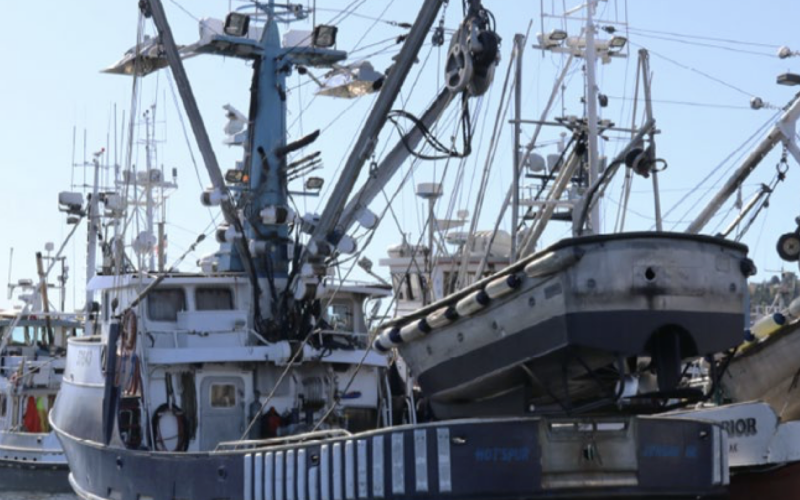An Alaska fishing crew had no warning from bilge alarms when their 53-foot purse seiner began flooding below deck and ultimately capsized, according to a new report from the National Transportation Safety Board.
The Hotspur was transiting through Dixon Entrance on Aug. 2, 2022, when the vessel began listing to port, according to the NTSB summary released Feb. 6.
As the listing increased, the captain and four crewmembers abandoned the vessel to a life raft and were rescued by good Samaritan vessels. Within about 20 minutes of the crew noticing the list, the vessel capsized and sank.
NTSB investigators determined the accident likely began with
flooding into the Hotspur’s lazarette, causing the vessel to lose stability, capsize and sink near Nunez Rocks, off the southern tip of Prince of Wales Island, Alaska.
The captain and four crewmembers abandoned the vessel to a liferaft. The Hotspur was declared a total loss at an estimated value of $1.2 million.
Built in 1988 by Workboats Northwest Inc., of Seattle, Wash., in 1988, the boat was acquired in 1995 by Hotspur Inc., a company owned by the captain of the vessel, who outfitted it as a purse seiner.
In addition to the captain, the crew consisted of four deckhands (one senior deckhand, one deckhand, and two junior deckhands). The captain had 39 years of experience in the fishing industry and 27 years running the Hotspu
On the day of the accident the Hotspur he was crossing the Clarence Strait on a northwesterly course at 6 knots, with the captain and senior deckhand in the wheelhouse, when they noticed the vessel listing slightly to port. Due to the port list, the captain decided to go down to the engine room and check the bilges and fuel tank levels while the senior deckhand remained at the helm.
In the engine room, the captain tried to correct the port list by draining (gravity transfer) some diesel fuel oil out of the port mid tank to the starboard day tank. During the transfer, the captain checked the engine room bilge and day tanks and noted that “everything looked normal, the bilge and everything looked fine.”
About 5 minutes into the fuel transfer, the senior deckhand noticed increased rolling to port. He saw the seas entering main aft deck via the freeing ports, submerging the vessel’s port quarter. He left the helm to notify the captain in the engine room that “we’re really listing now.” They both made their way up to the wheelhouse, and the captain took control of the helm and “tried to turn the boat into the [list].” However, he told investigators that “it just kept going and going and going.”
The captain recognized their dangerous situation and instructed the senior deckhand to alert the other crewmembers, who were in the galley at the time, to prepare the liferaft for abandoning ship. About 7:30 p.m., the captain used a handheld VHF radio to broadcast a distress call on channel 16. The nearby fishing vessel Lady Kodiak and sport fishing vessel The Codfather II responded to the call and diverted to assist.
The bilge alarms did not sound in the wheelhouse before the vessel list became severe. Investigators determined the alarms in the port void space or the lazarette were most likely inoperative. Had the bilge/water alarm level systems in these spaces been operable, the crew could have acted earlier to address the list.
“Automatic high-water bilge alarms are intended to provide crews with an early warning of vessel flooding,” the report concluded. “In inaccessible spaces, or small spaces with limited means or ability to inspect underway, bilge level-monitoring alarms are often the sole means to alert operators of space flooding. Operators should periodically test bilge high-water alarms and follow best marine practices and manufacturer recommendations for inspection and maintenance.”
The Hotspur was not salvaged so a post-casualty vessel examination could not be performed, the NTSB report notes.
“The captain and crewmembers said they were not aware of any damage to the vessel along the transit,” according to the report. “However, the hull plating in the engine room had corrosion and wastage that required repairs 3 weeks before the voyage. Without evidence that the vessel was damaged or that flooding originated from another source, it is possible that the flooding was caused by deterioration of the hull plating in another area, which went undetected. “
With the short time between the captain first noticing a list and the vessel capsizing, investigators determined the vessel likely had limited stability while underway immediately before the flooding. Because the Hotspur was less than 79 feet, it was not subject to U.S. Coast Guard commercial fishing vessel stability requirements. Without stability calculations and stability instructions, the vessel’s operator had limited understanding of the vessel’s center of gravity.
While Hotspur was functionally stable, the loading may not have provided an adequate margin of stability. The weight of the flood water, the free surface effect from the partially filled fuel tanks and the free surface created by the flooding decreased the vessel’s remaining stability, resulting in capsizing.
The full NTSB Marine Investigation Report 24-03 is available online.







